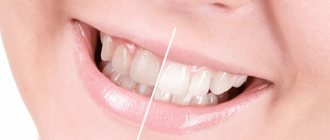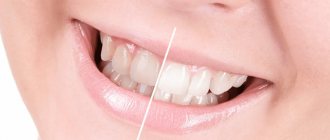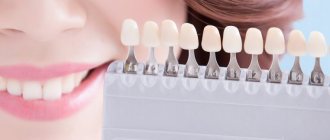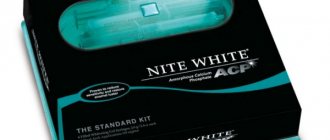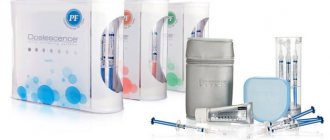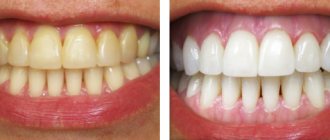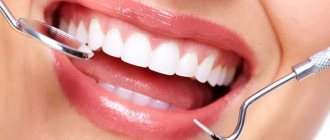Dr. Kizim
>
Articles
>
Teeth whitening: how long does the effect last?
The desire for white teeth of a perfectly even color is a natural desire of many patients who visit the dentist. Indeed, despite all efforts, even non-smoking and non-coffee-drinking patients are not always able to maintain white teeth. There is also such a factor as heredity, and here it will be difficult to argue with nature. However, it is always possible to make your teeth several shades lighter; another question is how long the teeth whitening lasts.
Causes of darkening of enamel
- Eating foods and drinks containing dyes;
- Having bad habits such as smoking;
- Past illnesses;
- Age-related changes in the human body.
If it is possible to compensate for the insufficient whiteness of teeth associated with the individual characteristics of the tooth structure only by using crowns, veneers and onlays, then compensation for darkening caused by external factors does not require such serious intervention. Modern cosmetic dentistry has a fairly large selection of methods and means for whitening tooth enamel.
In the question “
what is the safest and most effective teeth whitening ,” it is worth considering that the possible risks and complications of such procedures cannot be underestimated. Like any intervention, whitening has its indications and contraindications.
Recommendations for maintaining a snow-white smile for a long time
Reviews from doctors say that the results of professional whitening can last up to 3-5 years, but for this to be a reality, you must adhere to strict rules.
Rule No. 1. Minimum foods and drinks with dyes
In the first two weeks after bleaching, you generally need to adhere to a “white” diet, that is, eat only foods that have a neutral color and do not contain strong dyes: pasta, fermented milk, eggs, chicken fillet, fish. It is necessary to observe dietary restrictions, because immediately after exposure to bleaches, the enamel becomes more porous and literally attracts pigment to itself.
On a note! If you followed a diet for two weeks, as expected, and then went all out, then don’t expect that your Hollywood smile will last for many years. Reasonable dietary restrictions should always be adhered to, even after this period. Reduce the consumption of berries, sauces, tomatoes, red wines, and do not drink tea and coffee without milk. After eating “coloring” products, be sure to perform oral hygiene.
Rule No. 2. Give up bad habits
Professional teeth whitening is an expensive procedure. And it will be a shame if, due to smoking, the result disappears after 3-4 months. Therefore, try to give up the bad habit for at least 2 weeks after the procedure, or better yet, forever.
To maintain the results longer, you can try switching to electronic cigarettes, but if that doesn’t work, then at least every 3 months, contact your dentist to have professional oral hygiene done and remove smoker’s plaque.
Rule No. 3. Strengthen oral hygiene
Don't skip your daily oral care routine. Be sure to use not only a brush and paste, but also floss, rinse and irrigator.
Important! Carefully read the composition of rinses and pastes. Do not buy those that contain chlorhexidine, because it can stain the enamel dark.
Remove plaque not only in the morning and evening, but also after meals. To do this, just rinse your mouth with water or mouthwash; the interdental spaces can be cleaned with floss or irrigator.
Rule No. 4. Use of specialized tools
If you want to maintain the results for as long as possible, then specialized home whitening products will help with this. But there is one important condition - you need to use professional medications recommended by the dentist, and not folk recipes.
It’s good if you use specialized gels from manufacturers whose technology was used for professional whitening. For example, ZOOM or Amazing White. These are gels for home use - they are placed in individually selected trays. And they are designed specifically to preserve the results of the main whitening.
When should you start using such products? Not earlier than 3 months after the professional whitening procedure.
Contraindications for teeth whitening
- Age under 18 years;
- Individual intolerance (allergic reactions) to the components of substances used in the bleaching process;
- Pregnancy and breastfeeding;
- Completing a course of chemotherapy;
- Undergoing treatment with light-sensitive drugs (tretinoin, tetracycline antibiotics, etc.);
- Untreated caries and other destruction of dental units;
- Wedge-shaped tooth defects;
- Exposure of the neck of the dental units;
- Artificial crowns;
- Areas that have undergone filling or restoration, located in the area of intended bleaching;
- Periodontitis in the acute phase;
- Various wound lesions of the oral mucosa;
- The presence of a pronounced gag reflex.
Things to remember before any whitening procedure
- If you want the effect to be maximum, then before the procedure it is necessary to carry out professional cleaning. During the process, the specialist will prepare the teeth: remove plaque, make the surface even, smooth and susceptible to further exposure to lightening agents. Whitening can be carried out no earlier than 7–14 days after professional hygiene - during this time the enamel and gums will be restored.
- Two weeks before the session, it is necessary to begin strengthening the enamel with pastes with fluoride or calcium, and undergo a course of remotherapy or fluoridation. It is important to diversify the menu and add to the diet all groups of vitamins and microelements that are beneficial for teeth and gums - B, C, E, D, K, calcium, fluorine, phosphorus, iron, zinc. The lack of vitamins in food can be compensated with vitamin-mineral complexes.
- It is necessary to cure caries and all damaged teeth, stop the inflammatory process on the mucous membrane, if any.
- Immediately before the procedure, you need to eat, because after it it is not recommended to do this for 2-3 hours.
But you can change artificial crowns and old fillings only after whitening. Remember that composites and other materials (such as ceramics) cannot be lightened. The previous color of the structures will remain, and it is unknown whether it will match the new shade of your enamel.
Important! Not all teeth can be whitened. It will not be possible to achieve significant success if the enamel and the underlying dentin are naturally gray in color. Professional (and especially home) methods will not cope with severe fluorosis2 and hypoplasia. For the listed pathologies, it is better to choose an alternative - veneers or lumineers, crowns.
Risks of bleaching
- Increased sensitivity of tooth enamel;
- Changes in the structural state of the enamel;
- Possibility of premature wear of teeth;
- Changes in enamel strength, increased fragility and brittleness;
- Irritation of the mucous membranes located in close proximity to the procedure site.
It is in connection with the above factors that many people are interested in the question of which teeth whitening is the safest and most effective . There are two main whitening options:
- Dental;
- Homemade.
In both cases there are nuances that must be taken into account.
Whitening Pencil
The active ingredient in whitening pencils is still hydrogen peroxide. To lighten the enamel, a light gel is applied to the visible surface of the teeth using a special pencil applicator and left for the time specified in the instructions, after which the mouth must be rinsed thoroughly.
Difference between teeth whitening and teeth lightening
Before choosing the safest and most effective method of teeth whitening, it is worth understanding the difference between teeth whitening and teeth lightening - what is the difference between them? The main differences between these concepts come down to the following points:
- >Teeth whitening involves a chemical reaction to break down plaque. During the procedure, special oxidizing agents are used that penetrate the upper layers of enamel, giving a light shade to the teeth.
- The whitening procedure is different in that it is less chemically destructive and does not use many chemicals, however, the result will not be as effective and long-lasting as with teeth whitening.
By lightening, dentists mean gentle mechanical and abrasive methods of removing plaque. They do not use hydrogen peroxide and other compounds, but the result will not be as effective and durable. Based on this, we can conclude that teeth whitening has a number of bad consequences: uneven color, increased tooth sensitivity, and in rare cases, burns to the tissue of the lips or gums. However, today there are many safe and effective ways to whiten teeth , both in dentistry and at home.
How doctors whiten teeth
Conventionally, the entire process can be divided into successive stages:
- The doctor carefully examines the oral cavity and determines whether there are any dental diseases. If they are diagnosed, they are pretreated. Professional hygiene is mandatory. It cleanses the enamel and makes it more receptive to the lightening agent.
- Upon completion of preparation, the doctor isolates the mucous membranes of the mouth so that aggressive drugs do not come into contact with them. Then coats the teeth with gel. If necessary, he directs a lamp at them (in this case, the patient wears special safety glasses). You have to wait about fifteen or twenty minutes. Then the product is removed and the primary result is assessed. Afterwards the procedure is repeated again. In just one visit to the dental clinic, there may be two or three such repetitions - more is undesirable, since then the harm of teeth whitening will increase.
- Immediately after therapy, the dentition is treated with a strengthening remineralizing composition. It is needed to avoid increased tooth sensitivity.
It is important to agree with your doctor on the conventions. By holding the mouthguard in the mouth, the patient will not be able to tell if he is experiencing pain or other discomfort. Therefore, signs should be invented . For example, a wave of the left hand may indicate pain symptoms, while a nod of the head may indicate that everything is in order.
The patient should be aware that a slight tingling sensation in the area of the treated units is normal. But severe pain should not appear. If it occurs, under no circumstances should you wait until the end of the session. Sacrificing dental health for aesthetics is, to say the least, unwise. After all, you will then have to undergo a long recovery.
Methods of teeth whitening in dentistry
In this case, all procedures are carried out by a specialist in a clinical setting, using professional tools, equipment and techniques.
Mechanical whitening method
The whitening process uses specialized tools and attachments that effectively remove plaque and tartar deposits. At the moment, the most common methods of mechanical cleaning are recognized: ultrasonic cleaning and Air Flow sandblasting. It is difficult to call such procedures whitening, since they first of all remove deposits from the surface of the teeth and restore their natural color, eliminating nicotine plaque and the remains of coloring food fragments. This type of treatment involves exposing the tooth to a powerful, focused water-air jet containing abrasive particles. As a result of processing, the enamel is lightened by 6-7 tones and acquires a polished surface.
This type of teeth whitening is quite effective , as you can see a fairly quick effect and a low price.
Laser whitening
The essence of the procedure lies in the interaction of hydrogen peroxide and a laser beam, which serves as a kind of amplifier of the effect of the substance. In addition to the above, the laser makes the procedure the safest due to its ability to accelerate the process of peroxide penetration into the tooth enamel.
Stages of the procedure:
- Examination and assessment of the condition of the oral cavity for the presence (absence) of contraindications.
- Removing plaque and tartar deposits;
- Applying a gel containing high concentration hydrogen peroxide.
- Laser treatment at the rate of 30 seconds of exposure to each dental unit.
- Cleaning the oral cavity.
- Mineralization of enamel using fluoride-containing preparations.
Why is laser teeth whitening effective?
- Short time of impact. Unlike light whitening, which can last from 1 to 2 hours, the laser whitening procedure takes on average 30-40 minutes.
- High quality whitening, allowing you to achieve quick results with lightening by 8-10 tones on the Vita scale, and long-lasting results, varying from 3 months to a year or more.
- Relative harmlessness. The speed of exposure of the composition and the laser beam allows you to reduce the harmful effects on the enamel.
- Laser exposure has a disinfecting effect, which is the prevention of many diseases, including caries.
- Several laser treatments can not only whiten teeth, but also give them smoothness, due to which further staining of the enamel is significantly reduced.
- Mineralization, carried out at the end of the procedure, does not increase the sensitivity of the enamel, on the contrary, it strengthens and revitalizes it.
- Painless procedure.
Disadvantages of laser teeth whitening
- Relative negative aspects include the fairly high cost of the procedure.
- Smoking may minimize the results.
- An incorrectly performed procedure can lead to burns of the mucous membranes, damage to the enamel and increased sensitivity. the safest and most effective teeth whitening service, you can contact our clinic
Contraindications for laser whitening
- Deep and extensive damage to the enamel (caries, cracks, erosion, etc.);
- Availability of corrective and restorative systems (braces, veneers, dentures);
- Inflammation of the gums;
- Exposure of the root part of the teeth.
Photobleaching
The method is based on the combined effect of a specialized brightening composition containing hydrogen peroxide and urea and a light emitter that acts as an activator.
The following light sources can be used:
- LED lamps, cold glow. This type of lamp is recognized as one of the safest;
- Halogen lamps provide cold light, minimizing tissue injury;
- Ultraviolet lamps. Such lamps are now not often used, as they give an excessively heating effect.
The type of lamp is selected depending on the individual characteristics and type of structure of the teeth. One session of such whitening can last from 30 minutes to 1-2 hours, depending on the complexity, and lighten the enamel by 7-10 tones. The maximum effect is achieved after 3 sessions.
Photobleaching technologies
- Zoom technology. An important nuance of this technology is the addition of calcium phosphate to the lightening composition, which has a strengthening effect on the enamel. In this case, transillumination is carried out with an ultraviolet lamp. The maximum efficiency of this technology is lightening by 12 tones. UV lamps have a pronounced warming effect, but the high efficiency of teeth whitening of this type makes this technique quite popular;
- Amazing White technology. The targeted effect of the LED lamp breaks down peroxide molecules into oxygen, which brightens dentin and water;
- Beyond Polus technique. Involves a combination of halogen and LED lighting. Such interaction makes the procedure more gentle and safe. The procedure includes three cycles, 10 minutes each. The results obtained can last up to 12 months;
- Luma Cool technology. LED lamps with cold light are used. The session consists of three cycles, lasting 8 minutes. Exposure to LEDs is one of the safest and most gentle. The achieved result can last for several years.
Indications for photobleaching:
- Uniform darkening of the enamel without spots or pronounced stripes.
Contraindications to the procedure
- Pregnancy and breastfeeding;
- Age less than 18 years;
- The presence of thinned enamel with increased sensitivity;
- Carious lesions of dental tissues.
Benefits of photobleaching
- Rapid achievement of results that last for a period of 1 to 3 years;
- Photo whitening is extremely one of the safest methods of teeth whitening .
Negative sides
- Increased sensitivity of the enamel during the first time after the procedure;
- Does not have a brightening effect on foreign inclusions and systems (fillings, veneers, dentures);
- Quite a high price.
Photobleaching process
- Examination of the patient’s oral cavity and assessment of the patient’s condition in order to identify possible contraindications;
- Removing plaque and tartar deposits;
- Isolate the gums with a sterile film or protective gel and a lamp to prevent burns and irritation that may result from contact with the bleaching agent;
- The eyes of the patient and the doctor are protected with special glasses;
- Application of whitening gel. The gel is distributed in an even layer on the teeth of both jaws;
- The gel is irradiated by a lamp. The average session duration is about 30 minutes. The exposure time may decrease or increase depending on the desired result and the original shade;
- At the end of the procedure, the remaining gel is removed from the oral cavity;
- The number of repeated treatments is 3-4 sessions, depending on the desired result. The assessment is made using the Vita scale;
- The patient receives advice on care, allowing the results to be maintained for as long as possible.
On average, the result of such treatment can last from 1 to 3 years.
Chemical bleaching
The method is based on the impact on darkened enamel with various gel-like agents, which include carbamide or hydrogen peroxide, the percentage of which can vary from 10 to 45%. The methods of photobleaching and laser cleaning described above can essentially be considered varieties of chemical techniques, since all three methods use gels containing peroxide.
The main distinguishing feature of these methods is the mandatory presence of a laser or light lamp, which makes it possible to achieve the desired results when using peroxide in much smaller proportions. While the chemical method does not involve the use of auxiliary equipment, whitening occurs solely due to the composition applied to the surface of the teeth.
The chemical bleaching method is considered more gentle compared to laser or photo bleaching due to the absence of heating devices. However, the result of such bleaching is much less pronounced and amounts to approximately 5-6 tones. The procedure takes 60 minutes, and the achieved effect lasts from 1 to 1.5 years.
Indications for chemical teeth whitening
- Darkening of the enamel as a result of consuming foods (drinks) containing aggressive dyes;
- Tobacco smoking;
- Darkening of the enamel as a result of long-term use of certain medications;
- Age-related changes in enamel;
- Damage to the enamel and its darkening as a result of injury.
Contraindications
- The presence of high enamel sensitivity;
- Serious damage to the enamel layer (cracks, chips);
- Presence of untreated diseases of teeth and gums;
- Individual intolerance to the components of the lightening gel.
Stages of the procedure
- Examination of the patient’s oral cavity to determine the possibility of whitening;
- Isolation of gums using protective pads to prevent gel from entering, which can cause a burn;
- The teeth are isolated from the oral cavity to avoid saliva;
- Application of gel. The composition is applied using a special brush, evenly and layer by layer;
- After the required exposure is completed, the remaining gel is carefully removed.
Positive properties of the chemical lightening bleaching method
- Quick result, the beginning of which is noticeable after 15 minutes, and the final result is visible after 30-60 minutes;
- Relative safety, due to the absence of additional traumatic devices;
- Painless procedure.
Flaws
- The development of excessive reactivity on the part of the enamel is possible;
- Selectivity of the method;
- Risk of irritation or burn of the gums in case of contact with the bleaching composition.
Endobleaching (intracanal method)
Intra-canal bleaching, compared to the above, is a more coordinated measure and is used in cases where the darkening of the enamel is associated not with external, but with internal factors. The most common reason for endo-whitening is darkening of the tooth crown from the inside.
This can happen as a result of depulpation, the use of coloring filling materials, dental disease (pulp necrosis, pulpitis, pulp hemorrhage, hypercalcification) and serious injury to the crown of the tooth. The essence of the method is to inject a dye into the crown and then seal the entrance hole.
Indications for intra-canal bleaching
- Age-related darkening;
- Darkening associated with bad habits;
- Incorrect treatment carried out earlier and causing darkening of the tooth from the inside;
- Darkening associated with total injury to the internal tissues of the tooth.
Contraindications
- Pregnancy and breastfeeding;
- Age up to 18 years;
- Periodontitis;
- High level of enamel sensitivity;
- Diabetes;
- Thyroid diseases;
- Advanced carious lesions;
- Individual intolerance to the components of the composition;
- Inflammatory diseases of the oral cavity.
Advantages of the method
- Possibility of restoring the aesthetic appeal of teeth without prosthetics or installing veneers;
- Minimum possibility of complications;
- Relative painlessness;
- High performance, allowing you to achieve whitening by 10-12 tones;
- Relatively low cost;
- Long lasting results.
Disadvantages of endobleaching
- Using a drill;
- The appearance of fragility with frequent use of the method;
- Replacement of old filling material is required;
- The procedure may require several visits to the doctor.
It should be borne in mind that this method requires more thorough preparation than those previously described. One of the first stages of preparation is an x-ray examination, which allows you to clearly assess the problem and condition of the teeth. After the examination, a thorough visual examination and complete sanitation of the patient’s oral cavity are performed.
Stages of endobleaching
- Treatment of the oral cavity with an antiseptic;
- Selection of a suitable shade of enamel;
- Isolation of the tooth to be whitened;
- Removing old filling material;
- Thorough sanitation of the cavity;
- Isolation of canal mouths using a special lining;
- Introduction of a brightening agent into the prepared cavity;
- Sealing with installation of a temporary filling.
A repeat procedure is scheduled after 7 days. A total of 2 to 4 visits may be required. When the desired result is achieved, the doctor installs a permanent filling.
Due to the fact that the intracanal bleaching method involves deep intervention, the recommendations that should be followed are more serious.
So, in the first 7-10 days after the procedure it is not recommended:
- Give serious mechanical loads to the tooth being whitened;
- Eat foods that are sharply contrasting in temperature;
- Use viscous, enveloping foods and chewing gum;
- Chew actively on the side where bleaching was performed.
Recommendations after whitening
Features of caring for teeth and maintaining their “shape” depend on the type of whitening. Moreover, before the procedure it is necessary to carry out a number of preparatory manipulations.
- Examination of the oral cavity, X-ray examination and identification of possible contraindications. These include cancer, diabetes, allergies to ultraviolet radiation, and active dental diseases. Whitening is also contraindicated for pregnant women and people under 18 years of age.
- Professional oral cleaning.
- In-office whitening usually requires one procedure. After this, remineralizing therapy is carried out, which will restore the enamel after the procedure. To consolidate the results, a course of home whitening is prescribed, which can last up to a month. If the patient wants to undergo only a course of home whitening, he also needs to consult with a doctor, who will also help him choose the optimal system.
The most effective teeth whitening at home
Teeth whitening at home is a fairly common type of hygiene care. The modern market offers a fairly rich assortment of whitening products that differ in effectiveness and price ranges, so it is definitely impossible to answer the question: “ what is the most effective teeth whitening at home ”? It is worth considering that all home remedies, both improvised and manufactured in industrial conditions, will not allow you to achieve the same dramatic results that can be obtained with professional whitening in a clinic.
In addition, with careless and extremely intensive use of such products, there is a high probability of causing serious damage to tooth enamel and nearby tissues. This is due to the abrasives contained in pastes and other bleaching agents and the presence of irritating components, such as hydrogen peroxide. With frequent use, abrasive particles can thin the enamel and leave microdamages, which become a favorable environment for the accumulation of bacteria and staining particles. Hydrogen peroxide, if used incorrectly, can seriously injure mucous membranes, leaving burns and irritation.
Toothpastes with a whitening effect, gels, trays and pencils have gained the most popularity as some of the most effective ways to whiten teeth at home Currently, in pharmacies you can find various whitening pastes, which contain substances that gently and effectively remove plaque. You should use them no more than 1-2 times a week, since the abrasive particles contained in the paste spoil the enamel, and subsequently it can be easily stained by coffee, tea and other products.
AirFlow is not whitening
AirFlow is a technique that involves abrasively cleaning units. Some people think that it is aimed at lightening the enamel. In fact, this is not true. This is a standard hygiene procedure used to remove soft plaque and hardened tartar.
Since crowns are thoroughly cleaned during an AirFlow session, their appearance becomes much more aesthetically pleasing. However, there is no harm to oral health. Dentists recommend undergoing professional hygiene every year. This will keep your teeth and gums in good condition and reduce the likelihood of cavities forming.
Which teeth whitening is the safest and most effective: summary
When choosing which teeth whitening is the safest and most effective , you need to understand that it is almost impossible to achieve high results without the risk of damaging the enamel or the tooth as a whole at home. That is why it is more advisable to entrust this procedure to professional doctors.
If we talk about the safest and most effective teeth whitening in dentistry, then it is hardly possible to answer this question unambiguously, since any method has its pros and cons. The choice of whitening method is selected individually and is based on many aspects and nuances.
What determines the shade of teeth?
Many people dream of a perfectly white smile, but naturally white teeth do not exist. Yellow dentin is covered with enamel, the shades of which vary from white-gray to yellow-white. The more transparent the enamel, the yellower the teeth. The following factors also influence the shade:
- Abuse of tea, coffee, red wine and drinks that contain strong coloring agents.
- Regular smoking of tobacco. Nicotine, tar and various compounds instantly stick to porous enamel and change its shade.
- Frequent use of oral products containing chlorhexidine. It settles on the enamel and attracts dyes from tea and other drinks, so the teeth quickly darken.
- Use of liquid medicines with iron salts to treat anemia. The tooth enamel becomes brown.
- Use of rinses with stannous fluoride. Violet marks remain on sensitive enamel.
- Ignoring the rules of daily hygiene. A soft plaque accumulates on the teeth, which hardens over time and turns the enamel yellowish-brown.
- Development of fluorosis. The disease appears due to the accumulation of fluoride in the body. The enamel turns yellow and becomes covered with white spots.
Antibiotics of the tetracycline group also affect the shade of enamel. Tetracyclines have a pathogenic effect on the tooth buds, so they are not recommended for pregnant women and children under 8 years of age. Otherwise, the color of the enamel will vary from light yellow to brown.
Professional cleaning
Cleaning your teeth from plaque and hard deposits will return them to a healthy natural color, which, of course, will not be white, but definitely a tone or two lighter than without cleaning. In addition, such hygiene is very good for health. It reduces the risk of caries and other diseases. WHO recommends cleaning once or twice a year.
The most popular and effective methods:
- Airflow - plaque is removed using a special device that delivers a solution with crushed abrasive under pressure. This allows you to eliminate dark plaque that occurs due to consumption of coffee, tea, soda and other coloring foods, as well as due to exposure to cigarette smoke. As a result, the natural color of the teeth returns. This procedure can also serve as a preparatory step for cosmetic whitening.
- Ultrasonic cleaning is performed by a device (scaler) that generates ultrasonic vibrations that affect the enamel surface. This method can get rid of not only staining plaque, but also tartar. The procedure is completely safe.
